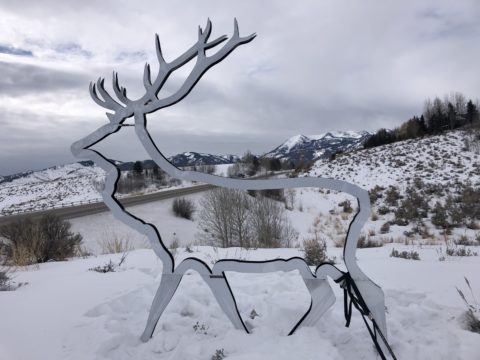What was your driving question?
Having learned that a nearby highway was a hotspot for wildlife-vehicle collisions, Teton Science Schools’ Mountain Academy 4th and 5th graders wondered, can we help “give wildlife a brake?”
Grades Involved
4th & 5th
What PBE principles were highlighted in this project?
Learner-Centered, Community as Classroom, Interdisciplinary Approach, Inquiry-Based
Project Description
With science teacher, Bari Bucholz, Mountain Academy 4th & 5th-grade students embarked on a Wildlife-Vehicle Collisions (WVC) project-based unit and as a culmination to the project, 2 reflective elk silhouettes have recently been installed on TSS’ Jackson Campus property along the north side of Highway 22. Bucholz said, “What really enhanced the project was all the collaboration with many community partners. We are grateful for the work they are all doing to reduce wildlife-vehicle collisions.”
The class worked closely with Renee Siedler, of the Jackson Hole Wildlife Foundation, and students to continue to receive data from her trail camera. They helped choose the location and installed it on campus in the fall. Students took initiative and raised funds to purchase an additional trail camera because they wanted to efficiently and effectively continue to collect and analyze data. Morgan Graham of the Teton Conservation District was also instrumental to the project. He engaged the students by sharing infrared trail cam footage taken from testing roadside reflectors along heavy migration corridors of mule deer. Seeing live video made this community issue real for the students and took the project to a whole new level.
Heather Overholser, Director of Teton County Public Works, joined the class to share how the County supports wildlife crossings, both presently and moving forward. We discovered that in 2023, construction on four separate underpasses will begin, thanks to a multimillion SPET tax that was passed in 2019. These crossings are at the HWY 22/390 intersection and Snake River Bridge on HWY 22. Additionally, the Wyoming Department of Transportation is currently finishing a project on S. HWY 89 with six wildlife underpasses. We also learned that the location west of Coyote Canyon Road on HWY 22 is the second-highest priority in the Teton County Master Plan and has future plans for mitigating wildlife conflict.
Amy Ramage, Teton County Engineer, shared potential renderings to give the students visual ideas of what the underpasses and overpasses might look like. After she extended the offer for us to host and manage the reflective elk silhouettes, the class used the Teton County GIS mapping tool to determine the most effective location and carefully considered collision hotspots. Bland Hoke, of Bland Design, created two life-size elk masterpieces and helped install them, as did Chris Colligan with the Greater Yellowstone Coalition who has been instrumental in local wildlife crossing projects.

How did this project connect to your local or regional community?
The Jackson Hole Wildlife Foundation reported 28 moose were killed on roads in Teton County from May 2018 through April 2019. During 2010 and 2011, the worst moose-vehicle collision year on record in Teton County, 33 moose-vehicle collisions were recorded over a 12-month period. An average year experiences around 18 moose-vehicle collisions in Teton County. “This is a significant concern for sustaining a healthy moose herd in Jackson Hole that is only several hundred strong at best,” warned Renee Seidler, the Foundation’s Executive Director. By contributing to WVC mitigations efforts, the students are playing an active role in local wildlife conservation.
How did this positively impact the community? How was it shared?
From now on, the ears of these students will perk up when they hear about wildlife mitigation measures. What might have stayed a dry scientific term now conjures memories of hard work, hands-on experiences, and collaboration with a wide range of community partners. Not only that, they will see reminders of their difference-making potential every time they catch sight of the two elk silhouettes adorning the hillside of their campus.
Reflection: What was the biggest challenge? What was the most rewarding aspect of this project?
Bari Bucholz commented, “One of the project’s highlights was the engagement of students while they were analyzing data to determine what species (large mammals) and which highways (WY 390, WY 22, and HWY 89) are identified as hotspots. These children are our future wildlife biologists, conservationists, engineers, artists, educators, and community members who truly want to make a difference.”
Any advice for a teacher or student that is implementing a PBE project for the first time?
Projects like this can’t happen without buy-in from the students and support from the community. As Bari Bucholz observed, “It takes a village and this is a great example of how local partnerships greatly enhance real-world education at Mountain Academy, while simultaneously making meaningful contributions to our community.”

